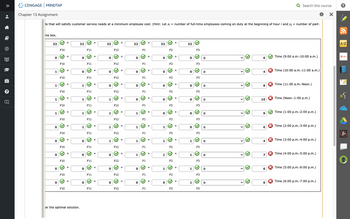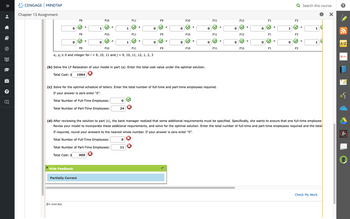
The Northside Bank is working to develop an efficient work
| Time | No. of Tellers | Time | No. of Tellers |
| 9:00 a.m.-10:00 a.m. | 6 | 2:00 p.m.-3:00 p.m. | 7 |
| 10:00 a.m.-11:00 a.m. | 5 | 3:00 p.m.-4:00 p.m. | 6 |
| 11:00 a.m.-Noon | 7 | 4:00 p.m.-5:00 p.m. | 8 |
| Noon-1:00 p.m. | 11 | 5:00 p.m.-6:00 p.m. | 7 |
| 1:00 p.m.-2:00 p.m. | 9 | 6:00 p.m.-7:00 p.m. | 5 |
Each full-time employee starts on the hour and works a 4-hour shift, followed by a 1-hour break and then a 3-hour shift. Part-time employees work one 4-hour shift beginning on the hour. Considering salary and
| (a) | Formulate an integer programming model that can be used to develop a schedule that will satisfy customer service needs at a minimum employee cost. (Hint: Let xi = number of full-time employees coming on duty at the beginning of hour i and yj = number of part-time employees coming on duty at the beginning of hour j.) |
| If your answer is zero enter “0” and if the constant is "1" it must be entered in the box. |
| (b) | Solve the LP Relaxation of your model in part (a). Enter the total cost value under the optimal solution. |
| Total Cost: $ | |
| (c) | Solve for the optimal schedule of tellers. Enter the total number of full-time and part-time employees required. |
| If your answer is zero enter “0”. | |
| Total Number of Full-Time Employees: | |
| Total Number of Part-Time Employees: | |
| (d) | After reviewing the solution to part (c), the bank manager realized that some additional requirements must be specified. Specifically, she wants to ensure that one full-time employee is on duty at all times and that there is a staff of at least four full-time employees. Revise your model to incorporate these additional requirements, and solve for the optimal solution. Enter the total number of full-time and part-time employees required and the total cost under the revised optimal solution. |
| If required, round your answers to the nearest whole number. If your answer is zero enter “0”. | |
| Total Number of Full-Time Employees: | |
| Total Number of Part-Time Employees: | |
| Total Cost: $ |


Trending nowThis is a popular solution!
Step by stepSolved in 5 steps with 10 images

- Scenario Office Equipment, Inc. (OEI) leases automatic mailing machines to business customers in Fort Wayne, Indiana. The company built its success on a reputation of providing timely maintenance and repair service. Each OEI service contract states that a service technician will arrive at a customer’s business site within an average of 3 hours from the time that the customer notifies OEI of an equipment problem. Currently, OEI has 10 customers with service contracts. One service technician is responsible for handling all service calls. A statistical analysis of historical service records indicates that a customer requests a service call at an average rate of one call per 50 hours of operation. If the service technician is available when a customer calls for service, it takes the technician an average of 1 hour of travel time to reach the customer’s office and an average of 1.5 hours to complete the repair service. However, if the service technician is busy with another customer when a…arrow_forwardstate whether or not each situation would be considered “compensable time” (and why or why not). An employee of a fast food chain has to arrive at work 15 minutes early to change into the“mascot” costume and it typically takes another 15 minutes at the end of the shift to change outof the costume and properly store it. Due to the cost of the costume, employees are notallowed to take the costume home. The “mascots” typically work from 10am – 2pm, to coverthe lunch rush periods. How much time would be “compensable” for the mascots, assumingthe conditions/schedule listed above?2) George is a Radiology Technician at a local hospital and when on call, is required to be nofurther than 30 minutes away from the facility. Is the “on call” time, compensable?arrow_forwardYou work as the administrative manager in charge of the operations of the medical services office that brings together over 10 specialists from different health fields. Each specialist has about 5 administrative employees who help with coding, billing, customer service, and other administrative tasks. You supervise all administrative employees. For two months you have noticed that a series of conflicts have arisen between the employees you supervise, which you must address promptly to avoid escalation. These are the conflicts that have been identified: A new position has been opened to supervise night operations and two of the employees have requested it. However, both have resorted to demonstrating that the other does not have the capabilities to rise to the position. These interpersonal differences have resulted in a tense work environment.It has been rumored that one of the medical specialists is going to retire, so it is possible that he will put the five administrative employees…arrow_forward
- A fast-food restaurant has a drive-thru window and during peak lunch times can handle a maximum of 60 cars per hour with one person taking orders, assembling them, and acting as cashier. The average sale per order is $9.50. A proposal has been made to add two workers and divide the tasks among the three. One will take orders, the second will assemble them, and the third will act as a cashier. With this system, it is estimated that 85 cars per hour can be serviced.arrow_forwardPlearrow_forwardConsider the table attached below:Assuming an M/M/1 setup, a service rate of 18 customers every 10 minutes, and a traffic intensity of 0.90.Assume a probability density function characterized by the exponential distribution.i). Compute the corresponding variates.ii). How robust is the above derived density function?arrow_forward
- establish the significance of random numbers in Monte Carlo simulations.arrow_forwardRollmore, a non-union manufacturing company decides it needs input on improving its work processes and procedures and decides to create employee committees to provide general feedback about things such as work rules and organizational policies and practices in hopes of improving efficiency. Rollmore asks ten employees to serve on such committees. Rollmore asks these employees to bring to their meetings, which include management representatives, concerns and ideas from their coworkers. Rollmore schedules these committees to meet once a month for two hours and provides lunch and a conference room for the participants. Are these employee committees legal or illegal? Why or why not?arrow_forwardA manager must decide which type of machine to buy, A, B, or C. Machine costs (per individual machine) are as follows: Machine Cost A $ 60,000 B $ 50,000 C $ 60,000 Product forecasts and processing times on the machines are as follows: PROCCESSING TIME PER UNIT (minutes) Product AnnualDemand A B C 1 16,000 3 4 4 2 10,000 6 5 1 3 15,000 1 3 6 4 17,000 5 3 4 Click here for the Excel Data File a. Assume that only purchasing costs are being considered. Compute the total processing time required for each machine type to meet demand, how many of each machine type would be needed, and the resulting total purchasing cost for each machine type. The machines will operate 10 hours a day, 240 days a year. (Enter total processing times as whole numbers. Round up machine quantities to the next higher whole number. Compute total purchasing costs using these rounded machine quantities. Enter the resulting total purchasing cost as a whole…arrow_forward
 Practical Management ScienceOperations ManagementISBN:9781337406659Author:WINSTON, Wayne L.Publisher:Cengage,
Practical Management ScienceOperations ManagementISBN:9781337406659Author:WINSTON, Wayne L.Publisher:Cengage, Operations ManagementOperations ManagementISBN:9781259667473Author:William J StevensonPublisher:McGraw-Hill Education
Operations ManagementOperations ManagementISBN:9781259667473Author:William J StevensonPublisher:McGraw-Hill Education Operations and Supply Chain Management (Mcgraw-hi...Operations ManagementISBN:9781259666100Author:F. Robert Jacobs, Richard B ChasePublisher:McGraw-Hill Education
Operations and Supply Chain Management (Mcgraw-hi...Operations ManagementISBN:9781259666100Author:F. Robert Jacobs, Richard B ChasePublisher:McGraw-Hill Education
 Purchasing and Supply Chain ManagementOperations ManagementISBN:9781285869681Author:Robert M. Monczka, Robert B. Handfield, Larry C. Giunipero, James L. PattersonPublisher:Cengage Learning
Purchasing and Supply Chain ManagementOperations ManagementISBN:9781285869681Author:Robert M. Monczka, Robert B. Handfield, Larry C. Giunipero, James L. PattersonPublisher:Cengage Learning Production and Operations Analysis, Seventh Editi...Operations ManagementISBN:9781478623069Author:Steven Nahmias, Tava Lennon OlsenPublisher:Waveland Press, Inc.
Production and Operations Analysis, Seventh Editi...Operations ManagementISBN:9781478623069Author:Steven Nahmias, Tava Lennon OlsenPublisher:Waveland Press, Inc.





